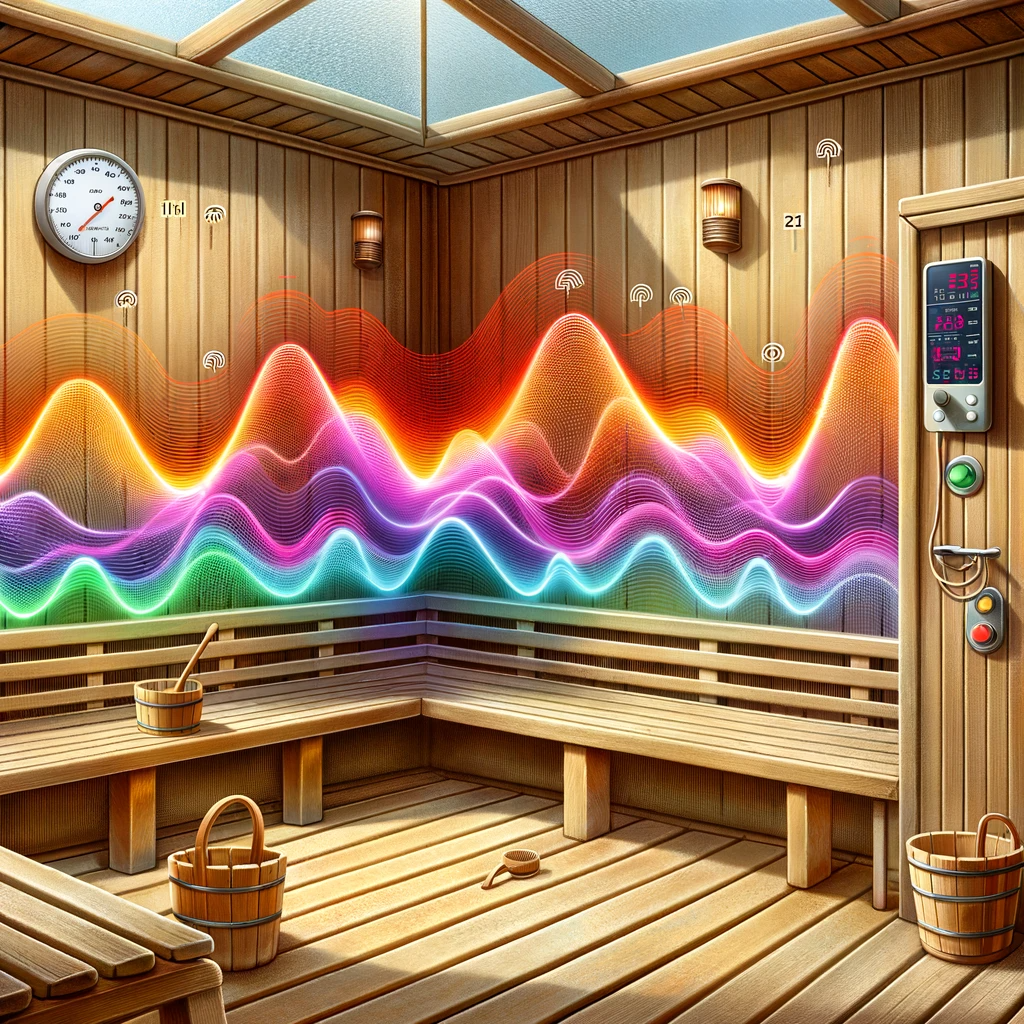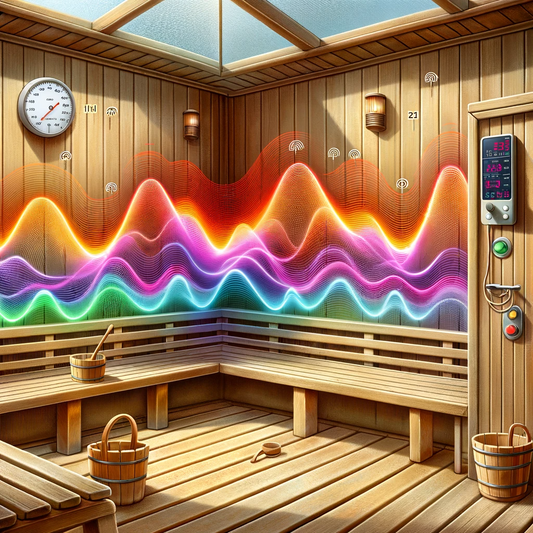As you venture in the exciting world of sauna kits for your home or backyard, you might encounter brands using terms like "Low EMF", “Ultra Low EMF”, or "Near-Zero EMF". Dissecting what these terms mean can be a bit confusing, but fear not! We're here to break it all down for you in a comprehensible and conversational manner. Let's delve into understanding EMF, its impact on health, and its association with infrared saunas.
What is EMF?
EMF stands for Electromagnetic Field. It's a physical field produced by electrically charged objects and affects the behavior of other charged objects in the vicinity of the field. EMF exposure is a topic of interest because it's ubiquitous in modern life due to the prevalence of electronic devices and wireless technologies.
The EMF spectrum includes 3 elements: 1) Extremely Low Frequency (ELF) radiation, which comes from electricity and its infrastructure, 2) Radiofrequency (RF) radiation from wireless devices, and 3) Infrared Radiation as well as Visible Light from the sun and artificial sources. Infrared saunas emit primarily in the infrared spectrum (as you might guess by its name), which is a type of non-ionizing radiation and is generally considered less harmful than ionizing radiation such as X-rays or gamma rays.
Does EMF Matter to My Health?
The full impact of long-term exposure to EMF on health is still under study, but initial research does suggest potential risks. According to the World Health Organization (WHO)[1], long-term exposure to EMF above certain levels can trigger adverse health effects such as headaches, anxiety, suicide and depression, nausea, fatigue and loss of libido.
What Are the Effects of EMF from Infrared Saunas?
Infrared saunas use infrared heaters to emit radiant heat which is absorbed directly by the skin. This means that the heat goes directly into your skin and body, rather than simply warming the air around you and then making you hot. As mentioned, there is some debate over the potential risks related to EMF exposure from infrared saunas. Some studies suggest that exposure to EMF shouldn't cause concern, others imply potential risks. Hence, the scientific community continues to study this relationship to reach a more conclusive understanding[2].
How are EMF signals measured and how can I test it?
EMF is measured using different units depending on the part of the spectrum:
- Electric fields are measured in volts per meter (V/m).
- Magnetic fields in the ELF range are usually measured in milligauss (mG) or microtesla (µT).
- Radiofrequency (RF) fields are typically measured in microwatts per square centimeter (µW/cm²) or volts per meter (V/m).
There are two main aspects of EMF that can be measured:
- Strength of the Field: This refers to the intensity of the field at a given point, which diminishes with distance from the source.
- Exposure Level: This is the amount of EMF an individual is exposed to over time.
There are a few ways that measurements can take place, and it’s important to note which ones might be relevant for infrared sauna usage.
- Spot Measurement: This gives you the EMF level at a specific location and time.
- Personal Exposure Measurement: This measures the EMF exposure of an individual over time, usually carried out with a personal EMF dosimeter.
- Area Survey: This is a comprehensive measurement over an area to map EMF levels.
Devices That Test for EMF Exposure:
There are various devices that can measure EMF exposure, but it is critical to point out that “you get what you pay for.” Many low cost EMF measurement devices will give wildly different readings and may not be trustworthy. Our friends at Golden Designs (a popular sauna maker, which produces not only Golden Designs, but also Maxxus saunas and Dynamic saunas) have made a very useful video illustrating how different EMF measurement devices vary in their accuracy.
- EMF Meters: These handheld devices can detect the strength of electric and magnetic fields. For infrared saunas, a meter that can measure low-frequency electric and magnetic fields would be appropriate.
- RF Meters: These are used for measuring higher frequency radiation from sources like cell phones and WiFi.
- Spectrum Analyzers: These can provide a more detailed analysis of EMF by showing the frequency and strength of individual sources.
- Dosimeters: These can be worn on the body to record cumulative EMF exposure over time.
For infrared saunas, the primary concern is usually the ELF range, since that's where infrared heaters emit. This means that when testing an infrared sauna for “EMF” we’d be measuring in milligauss (mG). Consumers might be concerned about the strength of these fields, particularly how they might affect the body over prolonged exposure periods.
Human Exposure Standards
While there is no standard specific to saunas regarding the labels “low EMF”, “ultra low EMF” or “near zero EMF”, various organizations have set exposure limits for EMF, regardless of what is emitting the EMF signals:
- International Commission on Non-Ionizing Radiation Protection (ICNIRP)
- Institute of Electrical and Electronics Engineers (IEEE) (behind a paywall)
- European Committee for Electrotechnical Standardization (CENELEC)
- EMF information from the World Health Organization (WHO) (not a “standard”)
These standards are designed to prevent all known harmful health effects of EMF exposure.
The distance from which measurements are taken have a significant impact on the readings. The EMF strength will be significantly reduced by moving away from the source of the EMF. An electric can opener, for instance, has an EMF strength of roughly 600 milligauss when it is 6 inches away, but just 2 milligauss when it is 4 feet away. Here are a few other common household devices that emit EMF
|
Hair Dryer 60 - 20,000 mG |
Microwave 200 - 300 mG |
Electric Can Opener 4 - 600 mG |
|
Vacuum Cleaner 300 - 400 mG |
Florescent Lamp 400 - 4,000 mG |
Hair Dryer 200 - 400 mG |
What ranges of EMF exposure are expected for each type of infrared sauna?
Each sauna manufacturer may have their own range as there is not one standard or governing policy that states what “low EMF” or “ultra low EMF” means. Below is a useful table for some common brands and what they publish as their range of EMF readings
|
Low EMF |
Ultra Low EMF |
Near Zero EMF |
|
|
Golden Designs, Inc. |
5 - 10 mG |
3 - 5 mG |
< 3 mG |
|
Dynamic saunas |
5 - 10 mG |
3 - 5 mG |
< 3 mG |
|
Maxxus saunas |
5 - 10 mG |
3 - 5 mG |
< 3 mG |
|
Enlighten |
0 - 3 mG |
||
Should I Only Get Near-Zero EMF Saunas?
Considering the potential health risks stated above, it might be a safer choice to opt for 'Low EMF' or 'Near-Zero EMF' saunas. However, it’s equally crucial to note that the 'EMF-free' badge should not be your sole determinant when buying a sauna. Also, take into account factors like the quality of materials used, ease of assembly, and energy efficiency.
At the end of the day, your choice of Low EMF, Ultra Low EMF, or Near Zero EMF saunas is a matter of personal preference and your concern for exposure. As you can see above, we’re surrounded by daily-use devices that emit EMF signals.
Personally, I would say that a Low EMF infrared sauna is the least of our concerns, given the range of EMF exposure listed above for devices like a microwave or smartphone. After doing tons of research to write this article, I know I will not be standing near the microwave or oven unless I need to. I’ll also do my best to avoid putting the smartphone up to my ear, preferring bluetooth headphones instead.
Below is a few of our Top Selling Infrared Saunas




